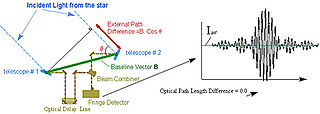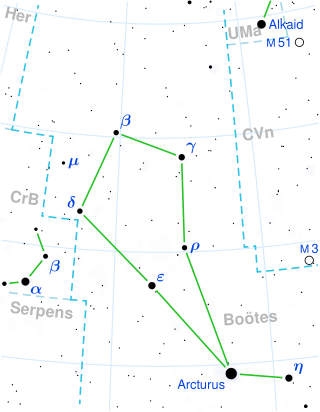Related Research Articles

Astrometry is a branch of astronomy that involves precise measurements of the positions and movements of stars and other celestial bodies. It provides the kinematics and physical origin of the Solar System and this galaxy, the Milky Way.

Hipparcos was a scientific satellite of the European Space Agency (ESA), launched in 1989 and operated until 1993. It was the first space experiment devoted to precision astrometry, the accurate measurement of the positions of celestial objects on the sky. This permitted the first high-precision measurements of the intrinsic brightnesses, proper motions, and parallaxes of stars, enabling better calculations of their distance and tangential velocity. When combined with radial velocity measurements from spectroscopy, astrophysicists were able to finally measure all six quantities needed to determine the motion of stars. The resulting Hipparcos Catalogue, a high-precision catalogue of more than 118,200 stars, was published in 1997. The lower-precision Tycho Catalogue of more than a million stars was published at the same time, while the enhanced Tycho-2 Catalogue of 2.5 million stars was published in 2000. Hipparcos' follow-up mission, Gaia, was launched in 2013.

Gaia is a space observatory of the European Space Agency (ESA), launched in 2013 and expected to operate until 2025. The spacecraft is designed for astrometry: measuring the positions, distances and motions of stars with unprecedented precision, and the positions of exoplanets by measuring attributes about the stars they orbit such as their apparent magnitude and color. The mission aims to construct by far the largest and most precise 3D space catalog ever made, totalling approximately 1 billion astronomical objects, mainly stars, but also planets, comets, asteroids and quasars, among others.

Epsilon Boötis, officially named Izar, is a binary star in the northern constellation of Boötes. The star system can be viewed with the unaided eye at night, but resolving the pair with a small telescope is challenging; an aperture of 76 mm (3.0 in) or greater is required.
The International Celestial Reference System (ICRS) is the current standard celestial reference system adopted by the International Astronomical Union (IAU). Its origin is at the barycenter of the Solar System, with axes that are intended to "show no global rotation with respect to a set of distant extragalactic objects". This fixed reference system differs from previous reference systems, which had been based on Catalogues of Fundamental Stars that had published the positions of stars based on direct "observations of [their] equatorial coordinates, right ascension and declination" and had adopted as "privileged axes ... the mean equator and the dynamical equinox" at a particular date and time.

Sigma Aquarii, Latinized from σ Aquarii, is a double star in the equatorial constellation of Aquarius, positioned about 1.3° to the south of the ecliptic. Due to its proximity to the ecliptic, this star is subject to occultation by the Moon. It has a white hue and is visible to the naked eye with an apparent visual magnitude of 4.81. Based upon parallax measurements, the distance to this star is approximately 175 light-years. It is drifting further away with a radial velocity of +11 km/s.
26 Aurigae is a binary star system in the northern constellation of Auriga. It is visible to the naked eye as a faint star with an apparent visual magnitude of 5.41.
40 Boötis is a single star located 166.5 light years away from the Sun in the northern constellation of Boötes. It is visible to the naked eye as a dim, yellow-white hued star with an apparent visual magnitude of 5.64. The star is moving away from the Earth with a heliocentric radial velocity of +12 km/s.
24 Cancri is a triple star system in the constellation Cancer. The system is located about 226 light-years away, based on its parallax. The system has a combined apparent magnitude of 6.5, and the two components A and B are separated by 5.7″.
HD 36678 is single star in the northern constellation of Auriga. This star is dimly visible to the naked eye with an apparent visual magnitude of 5.83. It is located at a distance of approximately 840 light years from the Sun based on parallax.

HD 128333 or CH Boötis is an irregular variable star in the northern constellation of Boötes. It is currently on the asymptotic giant branch of the HR diagram.

Zeta Chamaeleontis, Latinized from ζ Chamaeleontis, is a star located in the constellation Chamaeleon. Located around 540 light-years distant, it shines with a luminosity approximately 522 times that of the Sun and has a surface temperature of 15,655 K.

Lennart Lindegren is a member of the staff at Lund Observatory, Sweden, where he obtained his PhD in 1980, and became a full professor of astronomy in 2000. Space astrometry and its various applications has been his main focus in astronomy since 1976. His career has been marked by his continuous involvement in, leadership of, and profound contributions to, ESA's Hipparcos and Gaia missions over their entire duration.
74 Cygni is a visual binary star system in the northern constellation Cygnus, located around 249 light years distant from the Sun. It is visible to the naked eye as a faint, white-hued star with a combined apparent visual magnitude of 5.04. The pair orbit each other with a period of 1.57 years and an eccentricity of 0.5. The system is a source of X-ray emission, which is most likely coming from the secondary component.

V915 Scorpii is an orange hypergiant variable star in the constellation Scorpius.
64 Piscium is the Flamsteed designation for a close binary star system in the zodiac constellation of Pisces. It can be viewed with the naked eye, with the components having a combined apparent visual magnitude of 5.07. An annual parallax shift of 42.64 mas provides a distance estimate of 46.5 light years. The system is moving further from the Sun with a radial velocity of +3.76 km/s.

The Gaia catalogues are star catalogues created using the results obtained by Gaia space telescope.

HD 193002 is a solitary red hued star located in the southern constellation Telescopium. It has an apparent magnitude of 6.26, placing it near the limit for naked eye visibility, even under ideal conditions. The object is located relatively far at a distance of 1,030 light years based on Gaia DR3 parallax measurements, but it is approaching the Solar System with a heliocentric radial velocity of −9.1 km/s. At its current distance, HD 193002's brightness is diminished by 0.17 magnitudes due to interstellar dust and it has an absolute magnitude of −0.93.

HD 192827, also known as HR 7745 or rarely 83 G. Telescopii, is a solitary red hued star located in the southern constellation Telescopium. It has an apparent magnitude of 6.28, placing it near the limit for naked eye visibility. The object is located relatively far at a distance of 1,320 light years based on Gaia DR3 parallax measurements, but it is approaching with a heliocentric radial velocity of −43.7 km/s. At its current distance, HD 192827's brightness is diminished by 0.19 magnitudes due to interstellar dust and it has an absolute magnitude of −1.07.
Jean Kovalevsky was a French astronomer, specializing in celestial mechanics. He is known as a primary initiator and a leader of the Hipparcos space experiment.
References
- ↑ "Michael Perryman Mapping the stars with maths". ESA. Retrieved 24 April 2018.
- ↑ Lindegren, L; Perryman, M. A.C (1996). "GAIA: Global astrometric interferometer for astrophysics". Astronomy and Astrophysics Supplement Series. 116 (3): 579. Bibcode:1996A&AS..116..579L. doi: 10.1051/aas:1996136 .
- ↑ Perryman, M. A. C; De Boer, K. S; Gilmore, G; Høg, E; Lattanzi, M. G; Lindegren, L; Luri, X; Mignard, F; Pace, O; De Zeeuw, P. T (2001). "GAIA: Composition, formation and evolution of the Galaxy". Astronomy & Astrophysics. 369: 339–363. arXiv: astro-ph/0101235 . Bibcode:2001A&A...369..339P. doi:10.1051/0004-6361:20010085. S2CID 28973535.
- ↑ "'HIPPARCOS AND THE HR DIAGRAM". Royal Astronomical Society. February 1997. Retrieved 25 April 2018.
- ↑ "Michael Perryman" . Retrieved 24 April 2018.
- ↑ "JPL Small-Body Database Browser". NASA.
- ↑ "Laureates Academy Medal". Royal Netherlands Academy of Arts and Sciences. Archived from the original on 24 March 2019.
- ↑ "Tycho Brahe Prize to Prof. Michael Perryman" (PDF). European Astronomical Society Press Release. Retrieved 31 May 2012.
- ↑ Shaw Prize 2022